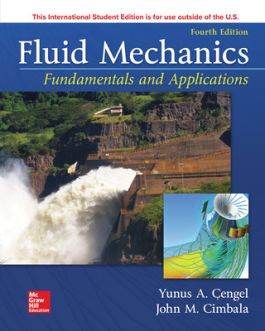Fluid Mechanics: Fundamentals and Applications
Receive via shipping:
- Colour, print bound version of the complete text
1) Introduction and Basic Concepts
2) Properties of Fluids
3) Pressure and Fluid Statics
4) Fluid Kinematics
5) Bernoulli and Energy Equations
6) Momentum Analysis of Flow Systems
7) Dimensional Analysis and Modeling
8) Internal Flow
9) Differential Analysis of Fluid Flow
10) Approximate Solutions of the Navier-Stokes Equation
11) External Flow: Drag and Lift
12) Compressible Flow
13) Open-Channel Flow
14) Turbomachinery
15) Introduction to Computational Fluid Dynamics
Appendix 1 - Property Tables and Charts (SI Units)
Appendix 2 - Property Tables and Charts (English Units)
Cengel and Cimbala's Fluid Mechanics: Fundamentals and Applications, communicates directly with tomorrow's engineers in a simple yet precise manner, while covering the basic principles and equations of fluid mechanics in the context of numerous and diverse real-world engineering examples. The text helps students develop an intuitive understanding of fluid mechanics by emphasizing the physics, using figures, numerous photographs and visual aids to reinforce the physics. The highly visual approach enhances the learning of fluid mechanics by students. This text distinguishes itself from others by the way the material is presented - in a progressive order from simple to more difficult, building each chapter upon foundations laid down in previous chapters. In this way, even the traditionally challenging aspects of fluid mechanics can be learned effectively.
McGraw-Hill's Connect, is also available as an optional, add on item. Connect is the only integrated learning system that empowers students by continuously adapting to deliver precisely what they need, when they need it, how they need it, so that class time is more effective. Connect allows the professor to assign homework, quizzes, and tests easily and automatically grades and records the scores of the student's work. Problems are randomized to prevent sharing of answers an may also have a "multi-step solution" which helps move the students' learning along if they experience difficulty.
McGraw Hill Connect is an award-winning digital teaching and learning solution that empowers students to achieve better outcomes and enables instructors to improve course management efficiency.
High-Quality Course Material
Our trusted solutions are designed to help students actively engage in course content and develop critical higher-level thinking skills while offering you the flexibility to tailor your course to the ways you teach and the ways your students learn.
Assignments & Automatic Grading
Connect features a question bank that you can select from to create homework, practice tests and quizzes. Dramatically reduce the amount of time you spend reviewing homework and grading quizzes, freeing up your valuable time to spend on teaching.
Analytics & Reporting
Monitor progress and improve focus with Connect’s visual and actionable dashboards. Reports are available to empower both instructors and students with real-time performance analytics.
Seamless Integration
Link your Learning Management with Connect for single sign-on and gradebook synchronization, with all-in-one ease for you and your students.


